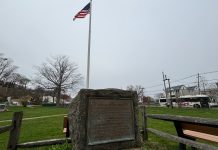By Torri Singer
RED BANK – The year-old borough change from parking meters to pay kiosks is touted in Borough Hall as a great improvement that has increased revenue, but talk to the people on the street and “horrible,” “ridiculous,” “poorly executed” and “confusing” are how they describe the system.
Much like how the pay phone has fizzled into near obsolesce, the parking meter is following suit. It’s been almost a year since Red Bank installed pay stations in the place of the traditional quarter-fed meters in the downtown borough lots. The pay station kiosks are located in the parking lots at North Maple Avenue, Marine Park, Union Street, Wharf Avenue, English Plaza and White Street.

According to William Wilk, the borough’s senior parking officer, 420 old meters were replaced with kiosks. “About 695 quarter-fed meters remain,” Wilk said.
“The majority of people like them. It’s more convenient for them and for us,” said Gary A. Watson, assistant administrative director of public utilities said.
While Wilk said the new system has brought the borough a 25 to 30 percent increase in parking revenue since the transition from meters to pay stations, many shoppers remain aggravated.
The luxury of throwing a coin into a meter and running into a shop for a quick errand is becoming a thing of the past; the lowest amount of time you can get at a kiosk is one hour for 50 cents. Business owners are taking note of what they describe as an inconvenience.
“It’s not good for our customer base,” said Dave Hendrickson, co-owner of the Fire House Specialty Shop on Broad Street. “Sometimes, it is confusing for older generations. People can’t figure out how it works and they can’t just run into a store for 10 minutes anymore so instead they just don’t come.”
But Wilk, who said the kiosk spaces are “absolutely” more cost efficient for the customer, disagrees. While the quarter-fed meters are $1 an hour, kiosk stations only cost 50 cents an hour.
Watson also said that some customers who don’t like the system haven’t taken the time to learn how it works.
Additionally, 15 parking spaces that line the right side of Broad Street have been reserved for valet parking after 5 p.m. daily.
With the availability of meters dwindling, some are opting to skip their trips altogether. “It’s horrible!” I’ll drive around for 30 minutes looking for metered spots,” said Jennifer Diehl, a Red Bank resident.
Linda Kain, a resident of Ocean County, agrees with those who still feel lost and frustrated with the new system after nearly a year. “I’ve done this three times; it confuses me every time,” Kain said. “I usually try to find a place where I don’t have to use it.”
While some recognize and appreciate features the pay stations offer, such as extending parking time by reloading the meter using a smartphone, those unhappy with the change are adamant about their dislike.

“It takes me an extra 20 minutes a day. If you’re a minute late, you get ticketed,” Ken Swain said. Swain, who has an office in Red Bank, said he was ticketed 40 times in the last calendar year since the installation of the new system. “It’s time-consuming, half the time the credit card doesn’t work, and the machine doesn’t accept it.”
Wilk, however, said he follows a protocol with the patron in mind. “There is a minimum time of 15 minutes, if I see that a car is overdue 15 minutes or less, I do not give them a summons.”
According to Wilk, the department does not view long kiosk lines as an issue because there are multiple stations in each lot.
“We also don’t hear many issues with credit cards not working, and if a machine has a problem, I receive a text message alerting me and I’m there to fix it,” Wilk said.
But, visitors say parking is a bigger hassle than ever.
Those in opposition to the new stations believe the kiosks require extra time, the lines that often form are not conducive to bad weather, people struggle to understand payment rates and frustration ensues.
However, like many technology transitions, this one requires an acceptance of the new – which may take some extra getting used to.














